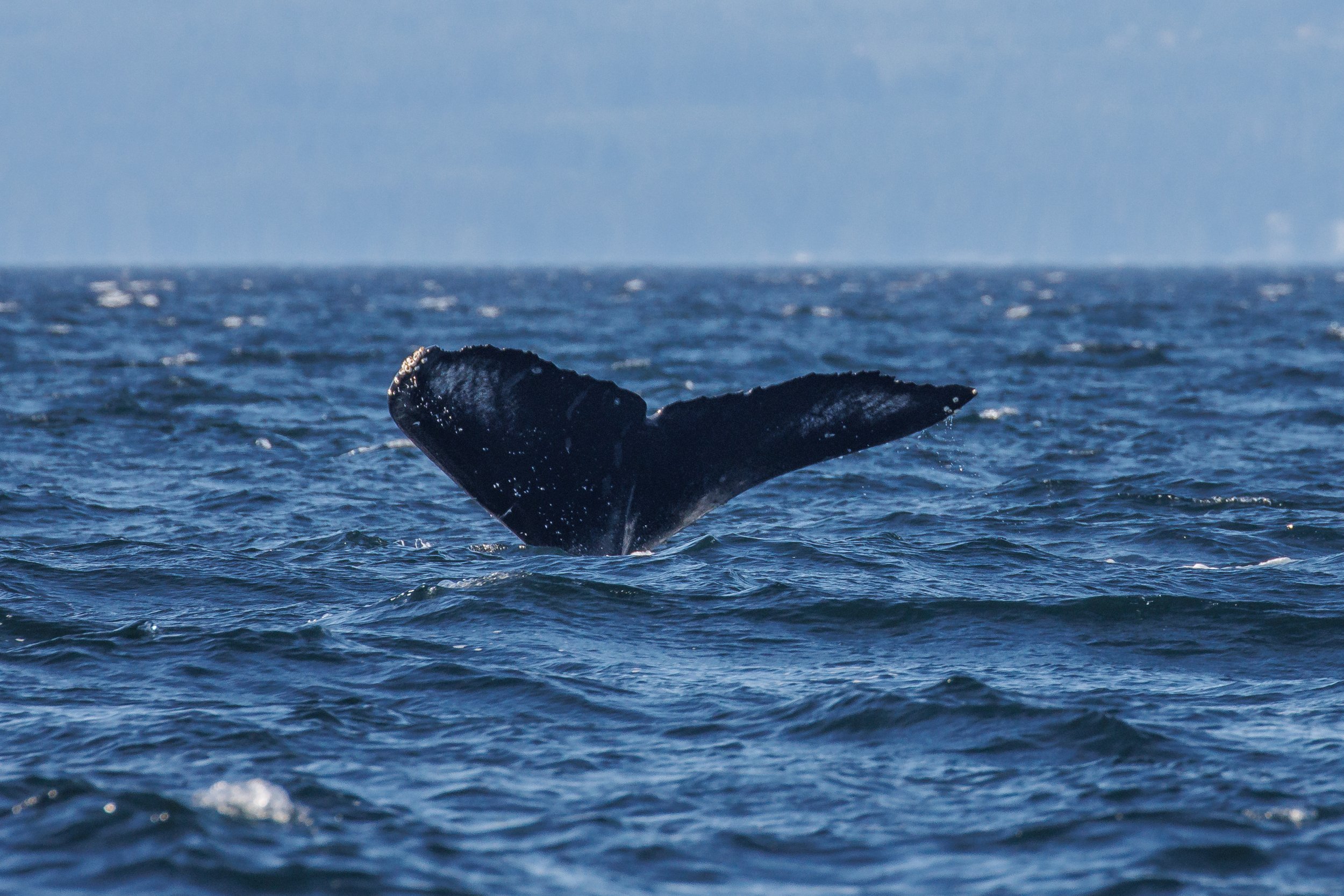August 16, 2023, 3:30 PM - A "Windy" afternoon
It was another fun August day when we pushed off in search of whales today. Today we were able to locate a group of 3 humpbacks socializing together. These humpbacks were identified as:
Windy (BCY0893), Hendrix (BCX2192) and Niagara (BCY0057)!
Normally when we observe humpbacks we do not know their gender. This species doesn’t display sexual dimorphism, meaning the females and the males look nearly identical. The only way we typically are able to tell them apart is if they show up in our area with a calf. However, there is one small physical difference between males and females that you can sometimes see if a whale is at the surface on its belly or lobtailing. The hemispherical lobe, a grapefruit-sized bump on the peduncle (the muscular area connecting the flukes/tail to the rest of the body), is a female-only adaption on humpback bodies. Scientists are not sure what this bump’s function is, but it is one of the only ways to successfully confirm the gender of a humpback. Windy and Niagara have both been confirmed males for rolling around or lobtailing and it has been noted that they are lacking hemispherical lobes. So today’s group of humpbacks consisted of two confirmed males and one confirmed female.
We have noticed that the males tend to come back to our area a lot more scarred up than the females do. This is likely occurring in the breeding grounds when males become competitive as they attempt to breed with females. While our humpbacks lack teeth to bite and fight back, they are equipped with large pectoral fins that can become covered in barnacles. Barnacles are very sharp - these encrusted pectorals can act similarly to a knife when swung around at each other.
After departing our humpbacks we set off in search of other wildlife. Today we found some sleepy Harbour seals and inquisitive Steller sea lions at Stinky Rocks. Our large male Stellers are beginning to return to our area from their summer breeding grounds. These big boys are always a marvel to see. Steller sea lion males are the largest sea lions in the world and can weigh up to roughly 2,500 lbs (~1,100 kg) - that’s heavier than a Smart car!
Photos by Marine Naturalists Des Poier and Vanessa Vereschahen.
Niagara showing off his beautiful fluke. Photo by Des Poirier.
Niagara. Photo by Des Poirier.
Hendrix preparing to dive. Photo by Des Poirier.
Hendrix going for a deep dive. Photo by Des Poirier.
Niagara about to go for a dive. Photo by Des Poirier.
Windy splashing around. Photo by Des Poirier.
Did you know we use the ventral side of the fluke to identify individuals? Photo by Des Poirier.
Hendrix going for a dive. Photo by Des Poirier.
A perfect shot of the ventral side of Windy’s fluke. Photo by Des Poirier.
Whales have to breathe air just like us, this is their blowholes! Photo by Des Poirier.
Windy was once satellite tagged. Can you see the circular scar? Photo by Des Poirier.
Do you see the barnacles on Windy’s tail? Humpbacks can carry up to 1000 pounds of barnacles on their body at any given time. Photo by Des Poirier.
We can also use the trailing edge of the fluke to help us identify individuals. Photo by Des Poirier.
Niagara’s fluke. Photo by Vanessa Vereschahen.
A younger male stellar sealion. Photo by Des Poirier.
The circular scarring on this stellar sea lion is likely from a cookie cutter shark. Photo by Des Poirier.
Those long whiskers help our sea lions navigate their world. Photo by Des Poirier.
Stellar sea lions hanging out in a cuddle puddle. Photo by Des Poirier.
A harbour seal staring at our boats. Photo by Des Poirier.
A harbour seal pup nursing from mom. Photo by Des Poirier.
Do you see the tongue hanging out? Photo by Des Poirier.
A juvenile great blue heron. Photo by Des Poirier.
Shore birds preening together. Photo by Des Poirier.
A cormorant sunning its wings on the cliffside. Photo by Des Poirier.
Cormorants flying. Photo by Des Poirier.
Our open boat Keta. Photo by Vanessa Vereschahen.


























